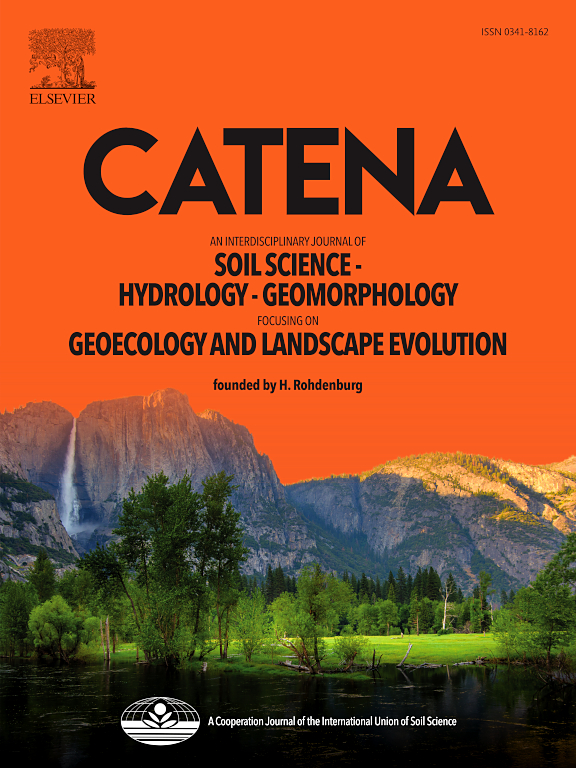Interplay of grazing intensity and topography on soil phosphorus dynamics in semiarid grasslands
IF 5.4
1区 农林科学
Q1 GEOSCIENCES, MULTIDISCIPLINARY
引用次数: 0
Abstract
The bioavailability of soil phosphorus (P) fractions is essential for sustaining primary productivity in grassland ecosystems, and it is influenced by grazing intensity and topographical features. However, the specific effects of grazing intensity on soil P fractions across varying topographies remain largely unexplored. Here, we utilized a 14-year grazing manipulation experiment in a semi-arid grassland, which included two topographical settings (flat vs. slope) and seven levels of grazing intensity (0 to 9.0 sheep ha−1), to investigate how these factors impact the storage and transformation of soil P fractions. Soil P fractions were categorized into labile P (Ca2-P), moderately labile P (Ca8-P, Al-P, Fe-P), and stable P (O-P, Ca10-P). Our results demonstrate that high grazing intensities lead to the accumulation of labile and moderately labile P fractions on flat areas due to runoff deposition from adjacent slopes, while these fractions are depleted on slopes themselves. Grazing exerts a direct influence on topsoil by reducing vegetation and litter cover, which accelerate the conversion of labile P fractions into more stable forms due to increased exposure and diminished protection. The mechanisms by which grazing impacts the distribution and dynamics of soil P fractions differ according topographical features. In flat areas, biochemical processes driven by soil organic carbon and microbial communities are predominant, resulting an initial decrease and followed by an increase in the proportion of less stable P with rising grazing intensity. Conversely, on slopes, environmental factors, particularly soil pH, play a more dominant role, leading to an initial increase followed by a decrease in the proportion of less stable P as grazing intensity escalates. These findings highlight the complex interplay between grazing intensity and topography in shaping soil P dynamics. Understanding these interactions is crucial for developing effective grazing management strategies and promoting sustainable grassland productivity in semi-arid environments.
半干旱草原放牧强度和地形对土壤磷动态的影响
土壤磷(P)组分的生物利用率对维持草地生态系统的初级生产力至关重要,它受到放牧强度和地形特征的影响。然而,放牧强度对不同地形土壤磷组分的具体影响在很大程度上仍未得到研究。在此,我们在半干旱草地上进行了为期 14 年的放牧操作实验,包括两种地形环境(平地与坡地)和七级放牧强度(0 至 9.0 羊只/公顷),以研究这些因素如何影响土壤磷组分的储存和转化。土壤钾组分分为易溶钾(Ca2-P)、中度易溶钾(Ca8-P、Al-P、Fe-P)和稳定钾(O-P、Ca10-P)。我们的研究结果表明,由于邻近山坡的径流沉积,高放牧强度会导致平地上的易流失和中度易流失磷组分的积累,而这些组分在山坡上则会消耗殆尽。放牧会减少植被和枯落物覆盖,从而对表土产生直接影响,而植被和枯落物覆盖的减少又会增加表土的暴露量并降低表土的保护作用,从而加速微量磷组分向更稳定形式的转化。放牧影响土壤磷组分分布和动态的机制因地形特征而异。在平坦地区,土壤有机碳和微生物群落驱动的生化过程占主导地位,导致最初的减少,随后随着放牧强度的增加,稳定性较低的磷比例增加。相反,在斜坡上,环境因素(尤其是土壤 pH 值)起着更主要的作用,随着放牧强度的增加,最初导致较不稳定钾的比例增加,随后减少。这些发现凸显了放牧强度和地形在影响土壤钾动态方面复杂的相互作用。了解这些相互作用对于制定有效的放牧管理策略和促进半干旱环境中可持续的草原生产力至关重要。
本文章由计算机程序翻译,如有差异,请以英文原文为准。
求助全文
约1分钟内获得全文
求助全文
来源期刊

Catena
环境科学-地球科学综合
CiteScore
10.50
自引率
9.70%
发文量
816
审稿时长
54 days
期刊介绍:
Catena publishes papers describing original field and laboratory investigations and reviews on geoecology and landscape evolution with emphasis on interdisciplinary aspects of soil science, hydrology and geomorphology. It aims to disseminate new knowledge and foster better understanding of the physical environment, of evolutionary sequences that have resulted in past and current landscapes, and of the natural processes that are likely to determine the fate of our terrestrial environment.
Papers within any one of the above topics are welcome provided they are of sufficiently wide interest and relevance.
 求助内容:
求助内容: 应助结果提醒方式:
应助结果提醒方式:


